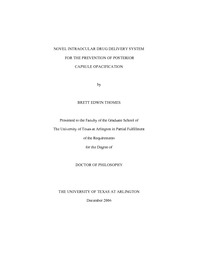
ATTENTION: The works hosted here are being migrated to a new repository that will consolidate resources, improve discoverability, and better show UTA's research impact on the global community. We will update authors as the migration progresses. Please see MavMatrix for more information.
Show simple item record
| dc.contributor.author | Thomes, Brett | en_US |
| dc.date.accessioned | 2007-08-23T01:56:06Z | |
| dc.date.available | 2007-08-23T01:56:06Z | |
| dc.date.issued | 2007-08-23T01:56:06Z | |
| dc.date.submitted | December 2006 | en_US |
| dc.identifier.other | DISS-1547 | en_US |
| dc.identifier.uri | http://hdl.handle.net/10106/121 | |
| dc.description.abstract | Posterior capsule opacification (PCO) is a major complication associated with the implantation of intraocular lens (IOLs). Evidence suggests that PCO formation is caused by abnormal lens epithelial cell (LEC) migration/proliferation. We hypothesize that pharmacologic agents must target inflammatory cells in addition to LECs to inhibit PCO formation. To successfully target both inflammatory cells and LECs, a novel intraocular drug delivery system (DDS) was developed for implantation in the lens capsular bag. Such a system permits direct delivery of anti-inflammatory and anti-proliferative drugs in the lens capsule for extended periods of time resulting in reduced PCO formation.
A lubricious polyurethane coating was selected as the drug delivery platform for this study based on a series of tests including lubricity, adhesion, leachable, stability, toxicity, and biocompatibility testing. In vitro studies were used to identify specific drugs that were capable of inhibiting inflammatory cell activation, LEC migration, and/or LEC proliferation at low concentrations (<0.01 mg/mL), including diclofenac (DI), colchicine (COL), mitomycin-C (MMC), 5-fluorouracil (5-FU), RGD-peptide, dexamethasone, and heparin (HEP). Results also demonstrated that these drugs were released from the coating at minimum effective levels past 10 days by varying coating properties.
In vivo studies (New Zealand white rabbit) demonstrated that the intraocular DDS using single drug and drug combinations including DI, COL, and MMC reduced IOL-associated foreign body reactions. Histological analysis provided evidence that cell adhesion to the IOL was significantly reduced compared to the control IOL. Histology also showed the effects of various drugs on ocular tissue and verified that optimal concentrations for each drug exist. When concentrations were not optimal, cellular responses were uninhibited and other side effects occurred including chronic inflammation.
Within the scope of this study, DI, COL, and MMC demonstrated the ability to inhibit inflammation and LEC migration/proliferation at low concentrations in vitro and in a rabbit model. The intraocular DDS demonstrated that it was capable of releasing drugs for prolonged periods of time and effectively reduced IOL-associated foreign body reactions and subsequent PCO formation processes. | en_US |
| dc.description.sponsorship | Tang, Liping | en_US |
| dc.language.iso | EN | en_US |
| dc.publisher | Biomedical Engineering | en_US |
| dc.title | Novel Intraocular Drug Delivery System For The Prevention Of Posterior Capsule Opacification | en_US |
| dc.type | Ph.D. | en_US |
| dc.contributor.committeeChair | Tang, Liping | en_US |
| dc.degree.department | Biomedical Engineering | en_US |
| dc.degree.discipline | Biomedical Engineering | en_US |
| dc.degree.grantor | University of Texas at Arlington | en_US |
| dc.degree.level | doctoral | en_US |
| dc.degree.name | Ph.D. | en_US |
| dc.identifier.externalLink | https://www.uta.edu/ra/real/editprofile.php?onlyview=1&pid=58 | |
| dc.identifier.externalLinkDescription | Link to Research Profiles | |
Files in this item
- Name:
- umi-uta-1547.pdf
- Size:
- 3.551Mb
- Format:
- PDF
This item appears in the following Collection(s)
Show simple item record


